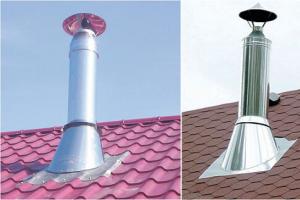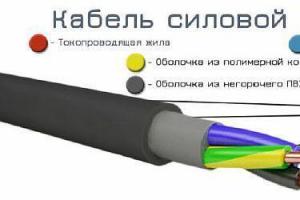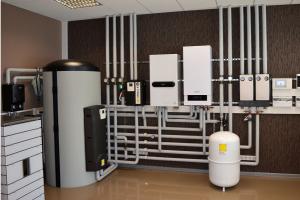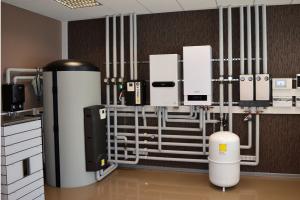There are devices that do not require either a stationary heating system or coolant to operate. Their use is convenient in any conditions, even in the absence of any communications. Gas infrared heaters from a cylinder operate using a supply of propane. And although this method of heating a room cannot be called the safest, it is quite popular among a wide range of users. Let's try to figure out why.
According to consumer reviews, the first and main advantage of heating with infrared gas heaters is the absence of requirements for connecting to any networks. In fact, such a heater can be installed anywhere.
All you need for the device to fully operate is a cylinder filled with liquefied gas. If you believe the reviews, gas infrared heaters for summer cottages may well work if they are connected to a centralized gas supply system.

Manufacturers claim that such equipment can be used anywhere: in an apartment in a multi-storey building, in a private house, in a garage, in a greenhouse, etc. At the same time, the device is quite mobile and, if necessary, can be easily transported. In addition, there are several types of heaters, allowing you to choose the most suitable option.
All gas heaters can be of two types:
- those that heat surrounding objects;
- those that release heat into the air.
If we talk about infrared heaters, they work on the following principle: objects are subject to heating, which, in turn, release heat into the air. This method is considered the most effective, but it has a significant drawback: objects that do not fall within the range of the device remain cold. It is pleasant to sit near such a heater, for example, while reading a book, but to heat the entire room you will need sufficient power from the device.

Gas infrared heaters from a cylinder: operating principle
The use of infrared heaters has some peculiarities. For example, in order for the device to cover a larger area, it must be placed as high as possible above the floor surface. In this case, the range of its influence will be as wide as possible, and the room will be quite warm.
The gas infrared heater consists of the following elements:
- body made of metal;
- heat exchanger;
- divider;
- automatic control unit;
- gearbox
As for the sizes of heaters, they can be very different: from small compact models to large devices designed for large rooms, warehouses, garages, etc.

Note! Keep in mind that some distance must be maintained between the heater and the gas cylinder. Otherwise, there is a risk of an explosion caused by a flame inside the device itself.
If we talk about the principle of operation of the device, we can distinguish the following processes:
- the flow of gas from the cylinder into the reducer, where the gas pressure decreases, after which it enters the heater nozzle;
- mixing of gas with air and their joint entry into the ceramic panel;
- uniform gas combustion and, as a result, a complete absence of combustion by-products;
- heating the ceramic component of the heater and further transfer of heat through infrared radiation.
As a result of the fact that the device heats the objects around it, the overall air temperature also increases. Therefore, infrared gas heaters are perfect for a summer house, garage or greenhouse.

How to choose a gas infrared ceramic heater
Before you buy a gas infrared heater for your cottage or home, you need to familiarize yourself with a number of characteristics that determine the purpose of this device. Depending on the power, as well as design features, each option is most suitable for specific operating conditions.
The main guideline when choosing infrared gas heaters is their safety, so here you should exercise maximum caution and attentiveness. A mandatory requirement for the purchased model is a built-in automatic shutdown system, which is triggered when the product overturns or is strongly tilted. Today, such a security measure is considered mandatory.
Note! Another useful feature is the automatic shutdown of the gas supply in case the burner is accidentally extinguished.
Where exactly the heater is planned to be placed also plays a major role in the choice. So, for residential premises it is necessary to have a special sensor that will indicate the level of carbon dioxide in the room. After all, during the combustion process carbon dioxide is released, which can accumulate. In large quantities, it is unsafe for both health and human life.

If there is a special sensor, the level of carbon dioxide in the room is regulated as follows: the device regularly takes a sample, determining the current level. At the same time, he checks it against the given boundary. If the current level has reached the limit, the device automatically switches off.
How to choose an infrared heater for your garden
In order to buy a gas infrared ceramic heater, you need to focus on the mode in which you plan to use it. Perhaps you will turn it on periodically when you come to the country for a few days. If long-term operation is planned, then the efficiency of the device will play a significant role, because its continued use will entail certain costs.
When choosing an infrared heater for your dacha, be sure to pay attention to the power of the device. There is a simple rule that you have to take into account: the more powerful the device, the less mobile it is. And, accordingly, vice versa. A simple and lightweight device will never be able to produce the same power as a massive, bulky heater.
The choice in this case is not affected in any way by the total area of the room. After all, such devices do not heat the entire room, so its size does not matter. Think in advance where you will install the heater and what area it will need to heat.

Helpful advice! It is always better to purchase a heater with a power reserve and not use it at maximum mode. This way you can heat a larger area if necessary.
The appearance of the device will also play a big role, because everyone will want the heater to fit naturally into the environment and not create visual discomfort.
Despite all its advantages, it still cannot be considered a full-fledged heating device if we are talking about permanent residence in the house. Its use is fully justified as an alternative for short periods of time, or as an additional source of heat.
How to choose an infrared gas heater for the garage
Buying a gas heater for a garage is one of the most difficult tasks. After all, initially this room is filled with a large amount of flammable substances, which, in combination with such equipment, create a fire hazard. Therefore, more stringent requirements are imposed on the safety of gas equipment.

According to the type of construction, portable models are considered the most suitable for a garage, since, if necessary, the direction of heat flow can be changed. In this type of room, it may be optimal to use a ceiling-mounted gas infrared heater.
Helpful advice! Think in advance about how the gas infrared heater will be serviced and repaired. There should be a free approach to all its elements.
Gas infrared heaters using bottled gas: prices for popular models
Due to its fairly wide popularity, buying a gas infrared heater from a cylinder is not difficult.
Prices for some popular heater models:
| Name | Power, W | Heating area, m² | Size, mm | Weight, kg | Average price, rub. |
| Floor-standing gas infrared heater Ballu Bigh 4 | 4500 | 60 or more | 270 (length) | 2,8 | 2800 |
| Gas infrared heater Ballu Bigh 3 | 3000-4500 | 45 | 338x278x372 | 2,3 | 2400 |
| Gas infrared heater Pathfinder Hearth with cooking capabilities | 1500 | 15 | 275x275x180 | 1,8 | 3000 |
| basic infrared heater NeoClima UK-02 | 2500 | 25 | 192x150x86 | 1 | 1300 |
| Outdoor gas infrared heater Master 34 CR | 3400 | 160x350x460 | 2,6 | 2200 |
Using reviews as a guide, the Ballu Bigh 55 Gas Infrared Heater is also a very good option. It has a high power of 4200 W, and also provides the ability to install a cylinder directly inside the device itself. Of course, this is reflected in its size.
Helpful advice! If you want to purchase a gas infrared heater for a greenhouse, then you need to choose among outdoor models. Room heaters will not cope with this task.
How to make a gas heater for a garage with your own hands
The price of a gas heater for a garage is not always acceptable, and in some cases you have to rely only on your own strength. Independent construction of heaters has long been tested, and simple and understandable instructions have been compiled for craftsmen.

Here are a few simple rules to consider before you even get started:
- The main requirement for both factory-made and home-made gas appliances is safety. Pay as much attention to this as possible.
- It is better to purchase ready-made (factory) elements that are responsible for supplying and shutting off gas, as they determine the safety of using the entire structure.
- The simpler the mechanism of operation of the device, the better.
- Pay attention to efficiency, otherwise using such a device can cost you dearly.
- Use inexpensive but high-quality components that will serve as a reliable foundation.
In order to make a high-quality heater with your own hands, you will need the following parts: a sheet of metal, scissors, rivets and a riveter for their installation, a fine metal mesh, a sieve and a gas cylinder. In addition, you cannot do without a special burner equipped with a valve.
First of all, you need to attach a heater to the burner. To do this, outline a sieve attached to a metal sheet with a marker. After this, you need to draw rectangular ears parallel and perpendicular to each other. Moreover, one of them should be 2 times longer than the others. Then, using metal scissors, you need to cut out the resulting design.

After this, the elements need to be fastened together: the burner is attached with bolts to the metal circle that was cut out. The ears are wrapped in opposite directions, and a strainer is attached to them, which will serve as a diffuser. This is a ready-made element of a homemade heater.
Next, you can proceed to attaching the metal mesh. For this purpose, you need to once again draw a circle with ears on a metal sheet and then cut it out. Next, you need to secure the mesh, which is attached to the ears of each of the circles, forming a mesh cylinder.
Helpful advice! It is most convenient to fasten using rivets and a riveter. In this case, you need to start by attaching the lower part, and only then move to the top.
When all the elements are ready, you can connect them together and connect the finished product to a power source.

If you can’t make the device yourself, then the main thing you should focus on when choosing a gas infrared heater from a cylinder is customer reviews, as well as the technical specifications specified by the manufacturer. Be sure to consider where exactly you plan to use it, as well as for what purpose. If you spend enough time choosing the right model, the purchased device will certainly meet all your expectations.
To heat a cottage or other room with a small area, it is best to purchase a gas heater. This device is capable of raising the temperature to a comfortable level in a short time and even providing heat to any outdoor place (terrace, tent, gazebo). All models can work autonomously, without connecting to the central highway.
According to the principle of operation and design, gas heaters for home and garden are divided into 3 types:
- infrared ceramic;
- convector;
- catalytic.
To warm an area of a certain size, such as a terrace or part of a huge warehouse, you should choose an infrared ceramic heater. Because, thanks to its characteristics, it is better suited than others for open spaces. The principle of operation of a gas infrared heater is as follows: the gas is mixed with the supplied air, then supplied to the ceramic tile, where it subsequently burns, thereby increasing the temperature of the heating element. By spreading thermal radiation, it heats objects around it, and from them the atmosphere warms up. The temperature of the heating element can reach 800°C or more, and no connection to the electrical network is required for operation.
The power of a gas ceramic heater for a summer residence varies from 1.2 to 4.2 kW, and the efficiency is more than 80%. Powered by gas cylinders or a central line, it is light in weight and ultimately easy to move. Another positive characteristic is that it does not dry out the air. It can also be installed not only on the floor, but also on walls and ceilings. Before choosing an IR heater for your dacha, you should remember that it does not heat the entire room, but only a certain area, so if you need to cover a large space, you should buy a device with high power and the ability to regulate it.

Convectors operate on the principle of convection, that is, cold air is supplied from a room or street into an insulated combustion chamber, where it is heated to the required temperature, after which it is released into the house. All combustion products are discharged outside through the tube. This is the main disadvantage of a convector gas household heater - it necessarily requires a ventilation system. The convector is usually installed under a window, it works both from gas from cylinders and from the main line, and to change the type of fuel it is enough to change the position of the switch. Power limits are 3-12 kW, well suited for country houses, offices, shopping pavilions and so on. Its main advantage is efficiency, which can reach 90%.

Gas catalytic heaters operate completely without flame and noise, which is why they are considered the safest. The average power is 2.9 kW, heating occurs due to the reaction of gas with the catalyst, as a result of which thermal energy is released, without the appearance of hazardous substances. The heating element can heat up to 500°C, but, judging by the reviews of experts, it is still recommended to use it in areas no larger than 20 m2.
In addition to fuel from gas cylinders, it can be powered by gasoline or electricity. Some models are equipped with fans, which increases the thermal output to 4.9 kW.
Product lines
1. Bartolini Pullover I Turbo Plus – gas ceramic heater with an additional fan heater. Capable of heating rooms with an area of up to 100 m2, it consists of 3 heating panels with a total power of 4.2 and a fan of 2 kW. There are functions of piezo ignition, adjustment of heating modes and gas control. It operates completely without being connected to the electrical network, and the fan heater can function without a heater. Consumption – from 120-330 g/hour.
2. Wall-mounted convector gas heater Alpine Air DT-2000 is a reliable and durable device thanks to a high-quality steel heat exchanger. With a power of 2.3 kW it heats rooms up to 35 m2. There are electric ignition functions and a temperature regulator. Air exhaust and intake are carried out only from outside the building. Consumption – 190 g/hour.

3. Bartolini Primavera K – gas catalytic heater with a power of 2.9 kW, heated area – no more than 35 m2. The device has all sorts of sensors built into it: tilt angle, measuring the amount of oxygen, gas control, as well as piezo ignition. Consumption – 210 g/hour.
4. Ceramic gas heater Timberk TGH 4200 SM1 has a power of 4.2 kW, which allows you to heat areas of 60 m2. It has 3 switching modes - 1.4, 2.8 and 4.2 kW, sensors for gas control, tilt, oxygen level. Easily moves with wheels. It comes with 2 clamps, a hose and a reducer for a gas cylinder. Consumption – 100-300 g/hour.
5. Ceramic infrared Hyundai Geiser H-HG1-42-UI577 differs from other models in its interesting and stylish appearance, as well as the presence of rollover protection. Power is 4.2 kW, there are 3 switching modes, the size of the heated area is from 30 to 60 m2. Consumption – up to 305 g/hour.

The most important characteristic to pay attention to is power. On average, 1 kW is required per 10 m2, so for a summer house with an area of 30 m2 you will need at least 3 kW. For rooms up to 20 m2 it is recommended to use catalytic gas heaters, for larger sizes - convector heaters, and for open and outdoor spaces - infrared ceramic ones. It is also better to choose models that have power adjustment, tilt and fall sensors (in this case, the gas supply will be automatically shut off), carbon dioxide control (if the level is high, the device will turn off) and a burner, if it suddenly goes out, and a piezo ignition function.

If you plan to use a gas heater for your dacha on an ongoing basis, then you should pay attention to its efficiency; in this regard, a convector heater is better suited, and for one-time use, especially on the street, an infrared one. Moreover, for this purpose there is a special portable model in the form of a lamppost. At its base there is a gas cylinder, and on a long pole there is an emitter. When choosing a collector-type device, you should definitely know the width of the wall of your house so that the pipe has a sufficient length.
Customers' opinions
 “For a long time I couldn’t decide which heater was better, but after studying many reviews and characteristics, I bought the Bartolini Pullover I. The area of my house is 50 m2 and it warms it up easily and quickly. It’s very good that there is a gas control function, since elderly parents often live with me, and wheels for moving. In general, I have only a positive opinion about Bartolini and now I recommend him to my friends. Price: about 9,000 rubles.”
“For a long time I couldn’t decide which heater was better, but after studying many reviews and characteristics, I bought the Bartolini Pullover I. The area of my house is 50 m2 and it warms it up easily and quickly. It’s very good that there is a gas control function, since elderly parents often live with me, and wheels for moving. In general, I have only a positive opinion about Bartolini and now I recommend him to my friends. Price: about 9,000 rubles.”
Alexander Romanenko, Moscow.
 “I have been planning to purchase an infrared gas heater for a long time and, after doing a short review of the characteristics, I decided to choose the Timberk TGH 4200 SM2. I was attracted not only by its interesting design, but also by the ability to regulate the power, for example, it quickly and well heated a room of 40 m2 in mode 2 - 2.8 kW. And we managed to buy it very inexpensively – only 4,500 rubles.”
“I have been planning to purchase an infrared gas heater for a long time and, after doing a short review of the characteristics, I decided to choose the Timberk TGH 4200 SM2. I was attracted not only by its interesting design, but also by the ability to regulate the power, for example, it quickly and well heated a room of 40 m2 in mode 2 - 2.8 kW. And we managed to buy it very inexpensively – only 4,500 rubles.”
Igor Groshev, St. Petersburg.
 “I’ve heard a lot of positive reviews about the Alpine Air DT-200 convector gas heater, especially about how quickly it heats the air and how it’s absolutely safe for children. And the price seemed low compared to other similar devices - a little more than 10,000 rubles. In my opinion, it is quite inexpensive, considering that it fully justifies itself. It was installed by specialists under the window opening on the wall. And what I really liked is that it takes air for heating from the street, and not from the house.”
“I’ve heard a lot of positive reviews about the Alpine Air DT-200 convector gas heater, especially about how quickly it heats the air and how it’s absolutely safe for children. And the price seemed low compared to other similar devices - a little more than 10,000 rubles. In my opinion, it is quite inexpensive, considering that it fully justifies itself. It was installed by specialists under the window opening on the wall. And what I really liked is that it takes air for heating from the street, and not from the house.”
Stepan, Novosibirsk.
 “Quite recently I got a dacha, but it doesn’t have main heating, so I decided to buy a Bartolini Pullover K gas catalytic heater, which came with a 24.5 liter composite cylinder. I chose this type of device because I heard a lot of reviews that with this operating principle it was considered the safest option. In addition, Bartolini is equipped with all kinds of sensors: gas control, shutdown when falling/tilting, oxygen level, and it’s convenient to carry thanks to wheels.”
“Quite recently I got a dacha, but it doesn’t have main heating, so I decided to buy a Bartolini Pullover K gas catalytic heater, which came with a 24.5 liter composite cylinder. I chose this type of device because I heard a lot of reviews that with this operating principle it was considered the safest option. In addition, Bartolini is equipped with all kinds of sensors: gas control, shutdown when falling/tilting, oxygen level, and it’s convenient to carry thanks to wheels.”
Nikolay, Yekaterinburg.
Price
Price table for gas heaters:
| Model | Device type | power, kWt | Maximum heated area, m2 | Cost, rubles |
| Bartolini Primavera K | catalytic | 2,9 | 35 | 11800 |
| Bartolini Pullover K Turbo Plus | 70 | 13700 | ||
| Hyundai Geiser H-HG1-42-UI577 | ceramic | 4,2 | 60 | 5000 |
| Hyundai Voyage H-HG1-42-UI576 | 5600 | |||
| Timberk TGH 4200 SM2 | 4500 | |||
| NeoClima UK-20 | 4600 | |||
| Alpine Air DT-2000 | convector | 2,3 | 35 | 10700 |
| Karma Beta Mechanic 3 | 3 | 30 | 22300 | |
| Mira H3 Wall 2 Karizma 3 kw | 20 | 9700 |
Be sure to follow safety precautions during use. Do not remove the protective grille or place any objects (clothing) on the heater or move it while it is on. It is dangerous to install near water sources (swimming pool, shower, bathtub) or place it in front of flammable materials. If you smell gas, you must immediately turn off the device and ensure the room is ventilated.
The Termomir company offers customers a wide range of gas heaters - gas convectors, gas infrared heaters and gas guns.
Gas heaters are divided into household and industrial; they can be used for heating a country house, cottage, warehouses and hangars, workshops, garages, construction sites, exhibition and trade pavilions, and other domestic, utility, technical or industrial premises.
Gas convectors
Gas convectors operate on the principle of natural air circulation using mains or liquefied (cylinder) gas. The design of such a heater is simple - a heat exchanger, burner, ignition device, gas fittings, control and safety unit, chimney. Cold air is taken from the room from the bottom of the device, gas is burned in the combustion chamber, the air around the heat exchanger is heated by the resulting heat and rises to the top, and combustion air is taken in and combustion products are removed through the chimney. For maximum efficient air circulation, there are models with a fan.
Gas convectors with a closed combustion chamber are suitable for residential and domestic premises, models with an open chamber are suitable for non-residential and utility premises with good ventilation.
Depending on the installation method, gas convectors can be wall-mounted, floor-mounted or ceiling-mounted and differ in power and appearance.
Gas infrared heaters
Infrared gas heaters come in different shapes, but are similar in design. They are equipped with a radiating panel that converts the energy obtained from gas combustion into infrared radiation. The heat generated by the heater is absorbed by all surfaces - floors, walls, furnishings, accumulated in them and then provides indirect heating of the air and an increase in the overall temperature in the room. The operation of such heaters is independent of temperature and air circulation, ceiling height, thermal insulation, so they are suitable not only for indoor, but also for open spaces - verandas, gazebos, terraces, and even for outdoor installation.
Infrared heaters usually run on liquefied gas, for example, outdoor heaters are “mushrooms” with a built-in gas cylinder, and therefore most often have a floor installation.
Thermal gas guns
Heat guns (fan heaters) have great power and high efficiency and are classified as industrial equipment.
A gas gun is an air heater that provides a powerful flow of warm air by burning gas. Such a device is equipped with a burner, combustion chamber, piezo ignition, gas fittings, control unit, safety devices and, of course, a powerful fan. At one end of the housing, air is taken from the room for heating and to ensure the gas combustion process, and at the other, heated air flow enters the room.
Gas guns operate on liquefied gas (propane and propane-butane), do not require special installation and are easily moved from place to place.
They are usually not used for residential premises, but are indispensable in construction, in various technological and production processes, for heating and drying premises and various materials, etc.
A large assortment of gas heaters of varying prices is presented below on the page and in the site menu. If you find it difficult to make a choice, contact our specialists for advice.
A ceramic gas heater is a device with infrared rays. It is powered by a gas cylinder, and the heating element is a ceramic panel. Such a heater does not heat the air, but the surfaces of objects. The gas heater must be installed on a flat and hard surface, in places where there is no wind.
Outdoor gas heaters are also very common. The principle of their operation is the same as that of indoor ones, but in appearance they are very different. The main difference is that the gas cylinder is hidden deep in the metal base of the heater, which makes it very convenient. They are often used in street cafes, gazebos, and dachas.
Gas Heater Safety
A significant advantage of this equipment is its safety.
If you accidentally drop your gas heater, it will automatically turn off. This will protect you from unwanted fires.
The device always works stably, but if malfunctions suddenly begin, the gas supply immediately stops.
The device is equipped with piezo ignition. Thanks to this device, you will start the equipment without any extra effort.
The heaters also maintain a certain temperature, so you can easily create a comfortable atmosphere in the room.
Gas heater for a summer house
The heating temperature of such heaters is up to 800 degrees. Therefore, you can easily heat a room of 60 square meters with it. meters. And you can adjust the heating power in three modes, setting the most optimal one for yourself. Depending on the model and size of the heating device, gas cylinders from 5 to 50 liters are used, which can be refilled at any gas station.
Gas heater for garage
Recently, such devices have become very common and are very popular. They are used to heat houses, construction sites, and garages. In garden plots they are suitable for heating greenhouses.
Our online store specializes in selling goods for the home and garden. Here you will find a large selection of gas heaters of different models and sizes.
For those who have already moved from city high-rise buildings to a cozy home, the issue of heating in winter is quite acute. As you know, the cheapest fuel at the moment is gas. So in this article we will look at what types of gas heaters there are, their advantages and disadvantages. So, first you should understand what gas heaters are and how they work. All models have common constituent parts, namely: These elements are found in all gas heaters - from budget to the most modern. More expensive models add convenience features such as a thermostat or automatic shutoff. There is one more common point for all models - they run on gas, natural or liquefied. Using the device, fuel is converted into heat. Such a heater can be connected to both main gas and bottled gas. All gas heaters are divided into portable and stationary. The first ones are usually used temporarily, that is, from time to time. They are small in size and weight and are most often placed on the floor. Their productivity is, of course, less. Such gas heaters are usually chosen for utility rooms or for summer cottages, as well as in the absence of a main gas supply. Such a unit will not withstand full and constant heating of a residential building. The second (stationary) gas heaters are devices powered by main or bottled gas. These devices are installed only in a permanent place and will cope with winter heating of the house. Such heaters are large, powerful and require additional equipment such as a chimney. Gas heaters are also divided according to their operating principle. There are three main categories: The large selection of different models often simply leads to a stupor. Which heater will be better? Unfortunately, there is no definite answer; each type is bad in some ways and good in others. To choose the unit that is suitable for your needs, you need to familiarize yourself with their pros and cons. We will not study it, since there are more modern and safer models. Instead, let's consider a new generation ceramic gas heater. Below are tables with the positive and negative characteristics of each type. These devices are very effective. As stated above, heating can occur in three ways. Some models are additionally equipped with fans for uniform heat distribution.Varieties
Pros and cons of different types of gas heaters
Catalytic

Infrared
pros
Minuses
Possibility of heating open and closed spaces. Such models are great for cafes, playgrounds or pool areas.
Burns oxygen. That is, ventilation is necessary in any case.
Large coverage area - outdoor models can heat objects at a distance of up to 6 meters.
Low fire protection. Even with the maximum protective measures taken by manufacturers, the device can cause a fire.
Mobility. Lightweight and compact models.
High efficiency.
In most cases, the device operates completely autonomously.
Ceramic
What you need to know when choosing
And yet, how to choose a gas heater? First you need to know exactly the purpose of the heater.

So, for open areas (sites, etc.), a unit in the form of a high lantern is recommended. It will heat a circular area, such as a terrace, playground or pool area.
When choosing a gas heater for your dacha, you should pay attention to floor-standing models.
For residential premises, a device with a catalytic operating principle is more suitable. This is the safest option for others.
If possible, you should pay attention to stationary gas heaters. These are ideal for a year-round home.
Infrared or catalytic - which is better?
With such a large selection of models and approximately the same combination of pros and cons, the question often arises: which gas heater is better - infrared or catalytic?
Here the answer will be clear: if the area of the heated room is less than 20 sq.m., it is worth taking a closer look at models operating on the catalytic principle.
Larger areas will be preferable.
The best gas heaters
To help you at least a little with your choice, we present an overview of the best gas heaters in different categories.
Main characteristics:
- floor;
- heats up to 60 cubic meters. m;
- power 4.2 kW;
- closed;
- weight 7.4 kg;
- electric ignition;
- gas control;
- three burner operating modes.
Powered by a gas cylinder, which is installed in a metal case. The delivery set includes a hose, reducer and clamps.
The device also has a CO2 sensor and tip-over protection. Convenient to move thanks to wheels.
The only negative is that you need to periodically ventilate the room.
The average price of the model is 4,800 rubles.

Main characteristics:
- wall;
- heats up to 30 sq. m;
- power 3 kW;
- weight 28.5 kg;
- thermostat;
- temperature adjustment;
- mechanical control.
The first thing that catches your eye is the unique design of the device: the body is black, the front panel is made of heat-resistant, impact-resistant glass. Very reminiscent of a fireplace.
This stationary heater can operate on both main and bottled gas.
Heats up the room quickly and looks great.
The price of the model is on average 25,000 rubles.

Main characteristics:
- street;
- heating diameter - 9 m;
- power 8 kW;
- weight 12.5 kg;
- height 2.2 m;
- wheels for moving;
- shutdown when tilted more than 45 degrees;
- mechanical ignition.
This model is perfect for gazebos, verandas and other outdoor recreation areas or cafes. Thanks to its stylish appearance, it will not only fit in, but also decorate any place.
The device uses the new Enders-Eco-Plus technology. It is this that provides heating at 12 kW with a real power of 8 kW.
The average cost of such a model is about 24,000 rubles.

Conclusion
There are many worthy models for different purposes, and it is quite difficult to list them all. We have selected the most popular ratings and presented you with their leaders. We hope that our article will help you make the right choice.
Warmth for your home!








